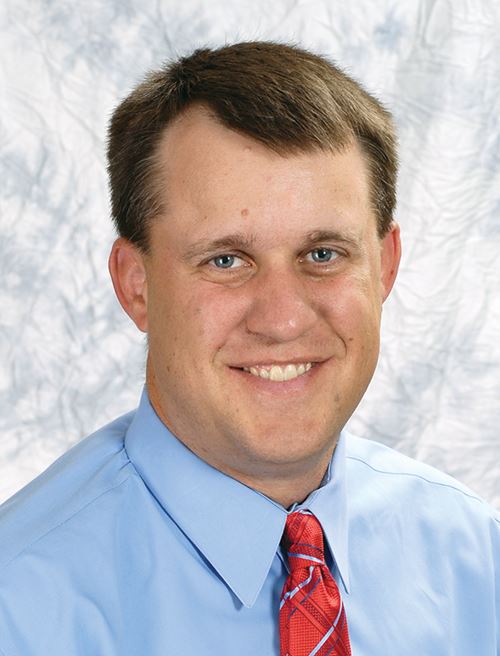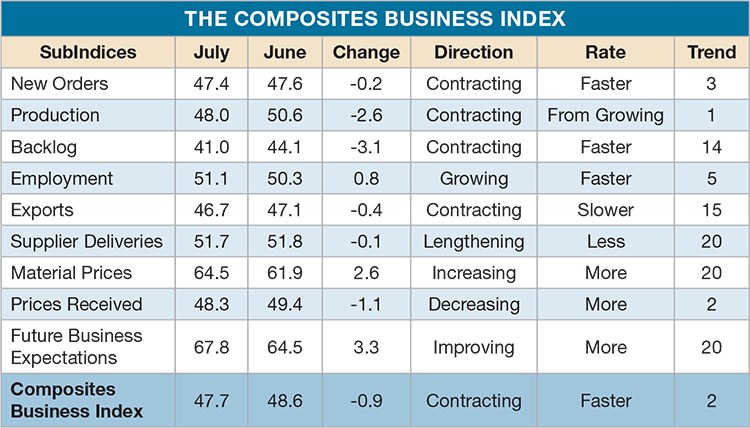Composites Business Index 47.7: Contraction accelerates
Cincinnati, Ohio-based Gardner Business Media's director of market intelligence and HPC columnist, Steve Kline, Jr., updates the Composites Business Index for June and July.
In June, the Composites Business Index (CBI) of 48.6 showed that composites business activity contracted for the first time since January this year. New orders contracted and did so at a faster rate than in May. Although it was the sixth consecutive month of production growth, production grew at a slower rate. The relatively strong performance of production compared to new orders, however, resulted in backlog contraction, which prolonged an already lengthy period of contraction, begun in June 2012, that could indicate excess capacity.
Employment grew again in June but did so at its slowest rate since January. With the dollar strong, exports continued to contract. Supplier deliveries lengthened as they have each month since the CBI was created in December 2011, but the rate of was the slowest since November 2012. This could indicate excess capacity in the composites supply chain.
Material prices increased in June, but the rate was among the slowest since November 2012. Prices received by fabricators decreased for the second time in three months. This hurt profitability and was another sign of excess capacity.
Business activity at large facilities outpaced that at small facilities through June. Shops with 100 to 249 employees reached their highest index level since January while shops with more than 250 employees reached their highest index level since July 2012. But shops with 50 to 99 employees contracted for the first time since December 2012, and shops with fewer than 50 employees continued to contract, but faster.
Regionally, the strongest performer in June was the West North Central. Also strong were the South Atlantic and West South Central. All others contracted.
Future capital spending plans were at their second lowest level of 2013. It was also the second time in 2013 that such plans fell below the historical average. Compared to June 2012, spending plans were down 26.7 percent.
With a reading of 47.7, the CBI for July showed that business activity in the composites industry contracted for the second month after peaking in March.
Employment was the only positive in July, expanding for the fifth straight month. All other subindices performed worse in July than in June. New orders contracted for the third month and at a slightly faster pace. Production moved from growth to contraction for the first time this year. Backlogs continued to contract, and contracted further than the other subindices. Backlogs contracted at their fastest rate for the year to date. Exports remained mired in contraction. Supplier deliveries continued to lengthen, having done so at a fairly constant rate in 2013.
Material prices increased in July at the fastest pace since March 2013. Prices received by fabricators decreased for the third time in four months. The combination of increasing material prices and decreasing prices received had a significant negative impact on profitability. But future business expectations improved noticeably in July. They reached their second highest level since May 2012.
Throughout 2013, the business activity at large facilities has been much higher than at small facilities — a trend amplified in recent months. Facilities with more than 250 employees have grown at a consistently strong rate since December 2012. Facilities with 50-249 employees grew in all but a couple of months in that same period. However, fabricators with fewer than 50 employees had contracted four straight months. Facilities with fewer than 19 employees contracted at the fastest rate since the CBI began.
In 2013, the strongest region is the West North Central, which has grown for five straight months. The Mountain region experienced the fastest growth rate in July, its first growth since February 2013. All other regions contracted.
Future capital spending plans were at their second lowest level since June 2012. Planned spending was more than 25 percent above the historical average. Compared to July 2012, spending plans in July 2013 were up by 16.1 percent.
Read Next
“Structured air” TPS safeguards composite structures
Powered by an 85% air/15% pure polyimide aerogel, Blueshift’s novel material system protects structures during transient thermal events from -200°C to beyond 2400°C for rockets, battery boxes and more.
Read MoreAll-recycled, needle-punched nonwoven CFRP slashes carbon footprint of Formula 2 seat
Dallara and Tenowo collaborate to produce a race-ready Formula 2 seat using recycled carbon fiber, reducing CO2 emissions by 97.5% compared to virgin materials.
Read MorePlant tour: Daher Shap’in TechCenter and composites production plant, Saint-Aignan-de-Grandlieu, France
Co-located R&D and production advance OOA thermosets, thermoplastics, welding, recycling and digital technologies for faster processing and certification of lighter, more sustainable composites.
Read More
.JPG;width=70;height=70;mode=crop)














.jpg;maxWidth=300;quality=90)





